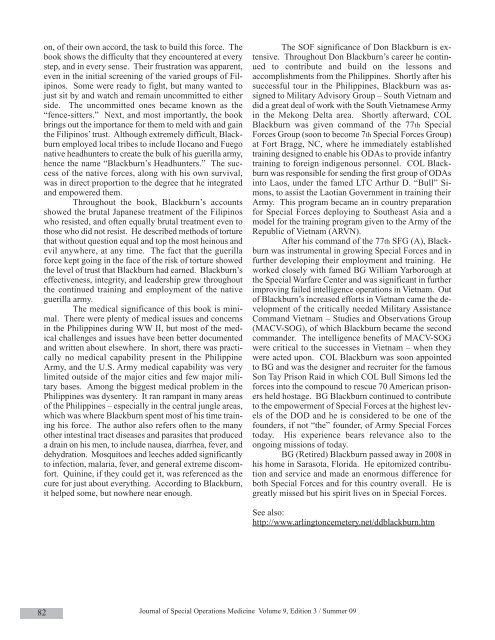Summer - United States Special Operations Command
Summer - United States Special Operations Command
Summer - United States Special Operations Command
Create successful ePaper yourself
Turn your PDF publications into a flip-book with our unique Google optimized e-Paper software.
on, of their own accord, the task to build this force. Thebook shows the difficulty that they encountered at everystep, and in every sense. Their frustration was apparent,even in the initial screening of the varied groups of Filipinos.Some were ready to fight, but many wanted tojust sit by and watch and remain uncommitted to eitherside. The uncommitted ones became known as the“fence-sitters.” Next, and most importantly, the bookbrings out the importance for them to meld with and gainthe Filipinos’ trust. Although extremely difficult, Blackburnemployed local tribes to include Ilocano and Fuegonative headhunters to create the bulk of his guerilla army,hence the name “Blackburn’s Headhunters.” The successof the native forces, along with his own survival,was in direct proportion to the degree that he integratedand empowered them.Throughout the book, Blackburn’s accountsshowed the brutal Japanese treatment of the Filipinoswho resisted, and often equally brutal treatment even tothose who did not resist. He described methods of torturethat without question equal and top the most heinous andevil anywhere, at any time. The fact that the guerillaforce kept going in the face of the risk of torture showedthe level of trust that Blackburn had earned. Blackburn’seffectiveness, integrity, and leadership grew throughoutthe continued training and employment of the nativeguerilla army.The medical significance of this book is minimal.There were plenty of medical issues and concernsin the Philippines during WW II, but most of the medicalchallenges and issues have been better documentedand written about elsewhere. In short, there was practicallyno medical capability present in the PhilippineArmy, and the U.S. Army medical capability was verylimited outside of the major cities and few major militarybases. Among the biggest medical problem in thePhilippines was dysentery. It ran rampant in many areasof the Philippines – especially in the central jungle areas,which was where Blackburn spent most of his time traininghis force. The author also refers often to the manyother intestinal tract diseases and parasites that produceda drain on his men, to include nausea, diarrhea, fever, anddehydration. Mosquitoes and leeches added significantlyto infection, malaria, fever, and general extreme discomfort.Quinine, if they could get it, was referenced as thecure for just about everything. According to Blackburn,it helped some, but nowhere near enough.The SOF significance of Don Blackburn is extensive.Throughout Don Blackburn’s career he continuedto contribute and build on the lessons andaccomplishments from the Philippines. Shortly after hissuccessful tour in the Philippines, Blackburn was assignedto Military Advisory Group – South Vietnam anddid a great deal of work with the South Vietnamese Armyin the Mekong Delta area. Shortly afterward, COLBlackburn was given command of the 77th <strong>Special</strong>Forces Group (soon to become 7th <strong>Special</strong> Forces Group)at Fort Bragg, NC, where he immediately establishedtraining designed to enable his ODAs to provide infantrytraining to foreign indigenous personnel. COL Blackburnwas responsible for sending the first group of ODAsinto Laos, under the famed LTC Arthur D. “Bull” Simons,to assist the Laotian Government in training theirArmy. This program became an in country preparationfor <strong>Special</strong> Forces deploying to Southeast Asia and amodel for the training program given to the Army of theRepublic of Vietnam (ARVN).After his command of the 77th SFG (A), Blackburnwas instrumental in growing <strong>Special</strong> Forces and infurther developing their employment and training. Heworked closely with famed BG William Yarborough atthe <strong>Special</strong> Warfare Center and was significant in furtherimproving failed intelligence operations in Vietnam. Outof Blackburn’s increased efforts in Vietnam came the developmentof the critically needed Military Assistance<strong>Command</strong> Vietnam – Studies and Observations Group(MACV-SOG), of which Blackburn became the secondcommander. The intelligence benefits of MACV-SOGwere critical to the successes in Vietnam – when theywere acted upon. COL Blackburn was soon appointedto BG and was the designer and recruiter for the famousSon Tay Prison Raid in which COL Bull Simons led theforces into the compound to rescue 70 American prisonersheld hostage. BG Blackburn continued to contributeto the empowerment of <strong>Special</strong> Forces at the highest levelsof the DOD and he is considered to be one of thefounders, if not “the” founder, of Army <strong>Special</strong> Forcestoday. His experience bears relevance also to theongoing missions of today.BG (Retired) Blackburn passed away in 2008 inhis home in Sarasota, Florida. He epitomized contributionand service and made an enormous difference forboth <strong>Special</strong> Forces and for this country overall. He isgreatly missed but his spirit lives on in <strong>Special</strong> Forces.See also:http://www.arlingtoncemetery.net/ddblackburn.htm82Journal of <strong>Special</strong> <strong>Operations</strong> Medicine Volume 9, Edition 3 / <strong>Summer</strong> 09
















